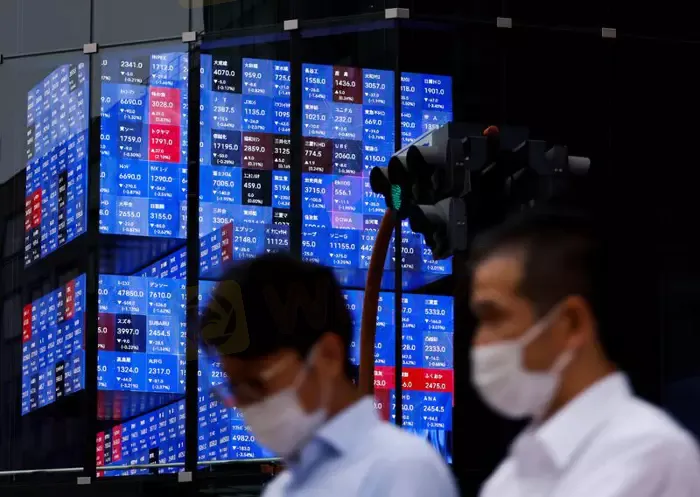简体中文
繁體中文
English
Pусский
日本語
ภาษาไทย
Tiếng Việt
Bahasa Indonesia
Español
हिन्दी
Filippiiniläinen
Français
Deutsch
Português
Türkçe
한국어
العربية
Asia shares mixed as China cuts rates, data disappoints
Abstract:Asian shares inched higher on Monday with investors anxious to see if Wall Street can sustain its rally as hopes U.S. inflation has peaked will be tested by likely hawkish commentary from the Federal Reserve this week.

Asian shares turned mixed on Monday after China‘s central bank trimmed key lending rates as a raft of economic data missed forecasts, underlining the need for more stimulus to support the world’s second largest economy.
Retail sales and industrial output both rose by less than expected in July, adding to a disappointing reading on new bank lending.
The cut in rates helped cushion the blow a little and Chinese blue chips edged up 0.1%, while the yuan and bond yields slipped.
MSCIs broadest index of Asia-Pacific shares outside Japan was flat, having bounced 0.9% last week.
Japans Nikkei rose 1.0% even though data showed the economy grew an annualised 2.2% in the second quarter, a touch under estimates.
Investors remain anxious to see if Wall Street can sustain its rally as hopes U.S. inflation has peaked will be tested by likely hawkish commentary from the Federal Reserve this week.
“The FOMC Minutes on Wednesday should reinforce the hawkish tones from recent Fed speakers of being nowhere near being done on rates and inflation,” warned Tapas Strickland, a director of economics at NAB.
Markets are still implying around a 50% chance the Fed will hike by 75 basis points in September and that rates will rise to around 3.50-3.75% by the end of the year.
Hopes for a soft economic landing will also get a health check from U.S. retail sales data that is expected to show a sharp slowdown in spending in July.
There is also a risk earnings from major retailers, including Walmart and Target, could be laced with warnings about a downturn in demand.
Geopolitical risks remain high with a delegation of U.S. lawmakers in Taiwan for a two-day trip.
EUROSTOXX 50 futures added 0.5% and FTSE futures rose 0.4%. S&P 500 futures and Nasdaq futures were both down around 0.2% after last weeks gains.
The S&P index is almost 17% above its mid-June lows and only 11% from all-time highs amid bets the worst of inflation is past, at least in the United States.
Peak inflation
“The leading indicators we observe provide support for moderation with easing supply pressures, weakening demand, collapsing money supply, declining prices and falling expectations,” said analysts at BofA.
“Key components of headline inflation, including food and energy are also at an inflection point. Both Wall Street and Main Street now expect inflation to moderate.”
The bond market still seems to doubt the Fed can manufacture a soft landing, with the yield curve still deeply inverted. Two-year yields at 3.26% are 42 basis points above those for 10-year notes.
Those yields have underpinned the U.S. dollar, though it did slip 0.8% against a basket of currencies last week as risk sentiment improved.
The euro was holding at $1.0249, having bounced 0.8% last week, though it shied away from resistance around $1.0368. Against the yen, the dollar steadied at 133.33 after losing 1% last week. [USD/]
“Our sense remains that the dollar rally will resume before too long,” argued Jonas Goltermann, a senior economist at Capital Economics.
“It will take a lot more good news on inflation before the Fed changes tack. The minutes from the last FOMC meeting and the Jackson Hole conference may well push back further against the notion that the Fed is ‘pivoting’.”
The pullback in the dollar provided something of a reprieve for gold which was up at $1,797 an ounce, having gained 1% last week. [GOL/]
Oil prices eased as Chinas disappointing data added to worries about global demand for fuel. Traders were also cautious in case progress was made on a possible European-brokered nuclear deal with Iran. [O/R]
Brent slipped 45 cents to $97.70, while U.S. crude fell 48 cents to $91.61 per barrel.

Disclaimer:
The views in this article only represent the author's personal views, and do not constitute investment advice on this platform. This platform does not guarantee the accuracy, completeness and timeliness of the information in the article, and will not be liable for any loss caused by the use of or reliance on the information in the article.
Read more

OPEC's Profound Influence on the Oil Market
At present, oil prices remain relatively stable, but global economic recovery and shifting market demands continue to drive price fluctuations. Amid an uncertain global economic and geopolitical landscape, OPEC’s policies and actions remain key determinants of oil prices.

What Are The Top 5 Cryptocurrency Predictions For 2025?
Discover the top 5 cryptocurrency predictions for 2025, including Ethereum's rise, a potential bear market, meme coin struggles, and regulatory shifts.

Think Before You Click: Malaysian Loses RM240,000 to Investment Scam
A manager from Sibu, Malaysia, lost RM240,000 to a fraudulent investment scheme.

What Euro Investors Can't Afford to Miss
For euro investors, geopolitical factors, inflation data, and the European Central Bank's policy direction will determine the market trends over the next few months.
WikiFX Broker
Latest News
Will Gold Break $2,625 Amid Fed Caution and Geopolitical Risks?
ECB Targets 2% Inflation as Medium-Term Goal
New Year, New Surge: Will Oil Prices Keep Rising?
PH SEC Issues Crypto Guidelines for Crypto-Asset Service Providers
FTX Chapter 11 Restructuring Plan Activated: $16 Billion to Be Distributed
Think Before You Click: Malaysian Loses RM240,000 to Investment Scam
Bithumb CEO Jailed and Fined Over Bribery Scheme in Token Listing Process
WikiFX Review: Something You Need to Know About Saxo
Is PGM Broker Reliable? Full Review
Terraform Labs Co-founder Do Kwon Extradited to the U.S. to Face Fraud Charges
Currency Calculator






